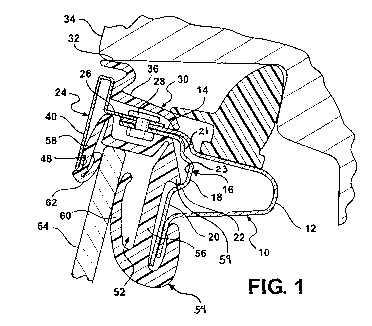Some of the information on this Web page has been provided by external sources. The Government of Canada is not responsible for the accuracy, reliability or currency of the information supplied by external sources. Users wishing to rely upon this information should consult directly with the source of the information. Content provided by external sources is not subject to official languages, privacy and accessibility requirements.
Any discrepancies in the text and image of the Claims and Abstract are due to differing posting times. Text of the Claims and Abstract are posted:
| (12) Patent Application: | (11) CA 2719819 |
|---|---|
| (54) English Title: | DOOR STRUCTURE WITH CO-EXTRUDED ROLL FRAME |
| (54) French Title: | STRUCTURE DE PORTE DOTEE D'UN CADRE ROULANT COEXTRUDE |
| Status: | Deemed Abandoned and Beyond the Period of Reinstatement - Pending Response to Notice of Disregarded Communication |
| (51) International Patent Classification (IPC): |
|
|---|---|
| (72) Inventors : |
|
| (73) Owners : |
|
| (71) Applicants : |
|
| (74) Agent: | KERSTIN B. BRANDTBRANDT, KERSTIN B. |
| (74) Associate agent: | |
| (45) Issued: | |
| (86) PCT Filing Date: | 2009-04-03 |
| (87) Open to Public Inspection: | 2009-10-15 |
| Availability of licence: | N/A |
| Dedicated to the Public: | N/A |
| (25) Language of filing: | English |
| Patent Cooperation Treaty (PCT): | Yes |
|---|---|
| (86) PCT Filing Number: | PCT/CA2009/000437 |
| (87) International Publication Number: | WO 2009124382 |
| (85) National Entry: | 2010-09-28 |
| (30) Application Priority Data: | ||||||
|---|---|---|---|---|---|---|
|
A motor vehicle door
includes a door frame including a
main body portion having a retention
wall. An upper reveal fixedly se-cured
to the door frame and includes
an outer wall. The outer wall of the
upper reveal and the retention wall
of the door frame define a channel
therebetween. Each of the outer wall
and the retention wall engage a glass
run to retain the glass run within the
channel.
Une porte de véhicule automobile comprend un cadre de porte comprenant une partie de corps principal dotée dune paroi de rétention. Un battant supérieur est attaché fixement au cadre de porte et comprend une paroi extérieure. La paroi extérieure du battant supérieur et la paroi de rétention du cadre de porte définissent un canal entre elles. Chacune des paroi extérieure et paroi de rétention met en prise une coulisse de vitre pour retenir la coulisse de vitre dans le canal.
Note: Claims are shown in the official language in which they were submitted.
Note: Descriptions are shown in the official language in which they were submitted.

2024-08-01:As part of the Next Generation Patents (NGP) transition, the Canadian Patents Database (CPD) now contains a more detailed Event History, which replicates the Event Log of our new back-office solution.
Please note that "Inactive:" events refers to events no longer in use in our new back-office solution.
For a clearer understanding of the status of the application/patent presented on this page, the site Disclaimer , as well as the definitions for Patent , Event History , Maintenance Fee and Payment History should be consulted.
| Description | Date |
|---|---|
| Inactive: IPC expired | 2016-01-01 |
| Application Not Reinstated by Deadline | 2015-04-07 |
| Time Limit for Reversal Expired | 2015-04-07 |
| Inactive: Abandon-RFE+Late fee unpaid-Correspondence sent | 2014-04-03 |
| Deemed Abandoned - Failure to Respond to Maintenance Fee Notice | 2014-04-03 |
| Inactive: Cover page published | 2010-12-23 |
| Inactive: Notice - National entry - No RFE | 2010-12-04 |
| Inactive: IPC assigned | 2010-11-24 |
| Inactive: IPC assigned | 2010-11-24 |
| Inactive: IPC assigned | 2010-11-24 |
| Inactive: First IPC assigned | 2010-11-24 |
| Application Received - PCT | 2010-11-24 |
| National Entry Requirements Determined Compliant | 2010-09-28 |
| Application Published (Open to Public Inspection) | 2009-10-15 |
| Abandonment Date | Reason | Reinstatement Date |
|---|---|---|
| 2014-04-03 |
The last payment was received on 2013-03-12
Note : If the full payment has not been received on or before the date indicated, a further fee may be required which may be one of the following
Please refer to the CIPO Patent Fees web page to see all current fee amounts.
| Fee Type | Anniversary Year | Due Date | Paid Date |
|---|---|---|---|
| Basic national fee - standard | 2010-09-28 | ||
| MF (application, 2nd anniv.) - standard | 02 | 2011-04-04 | 2011-03-22 |
| MF (application, 3rd anniv.) - standard | 03 | 2012-04-03 | 2012-03-14 |
| MF (application, 4th anniv.) - standard | 04 | 2013-04-03 | 2013-03-12 |
Note: Records showing the ownership history in alphabetical order.
| Current Owners on Record |
|---|
| MAGNA INTERNATIONAL INC. |
| Past Owners on Record |
|---|
| HARUHISA KAWASE |
| PETER J. ELLIS |